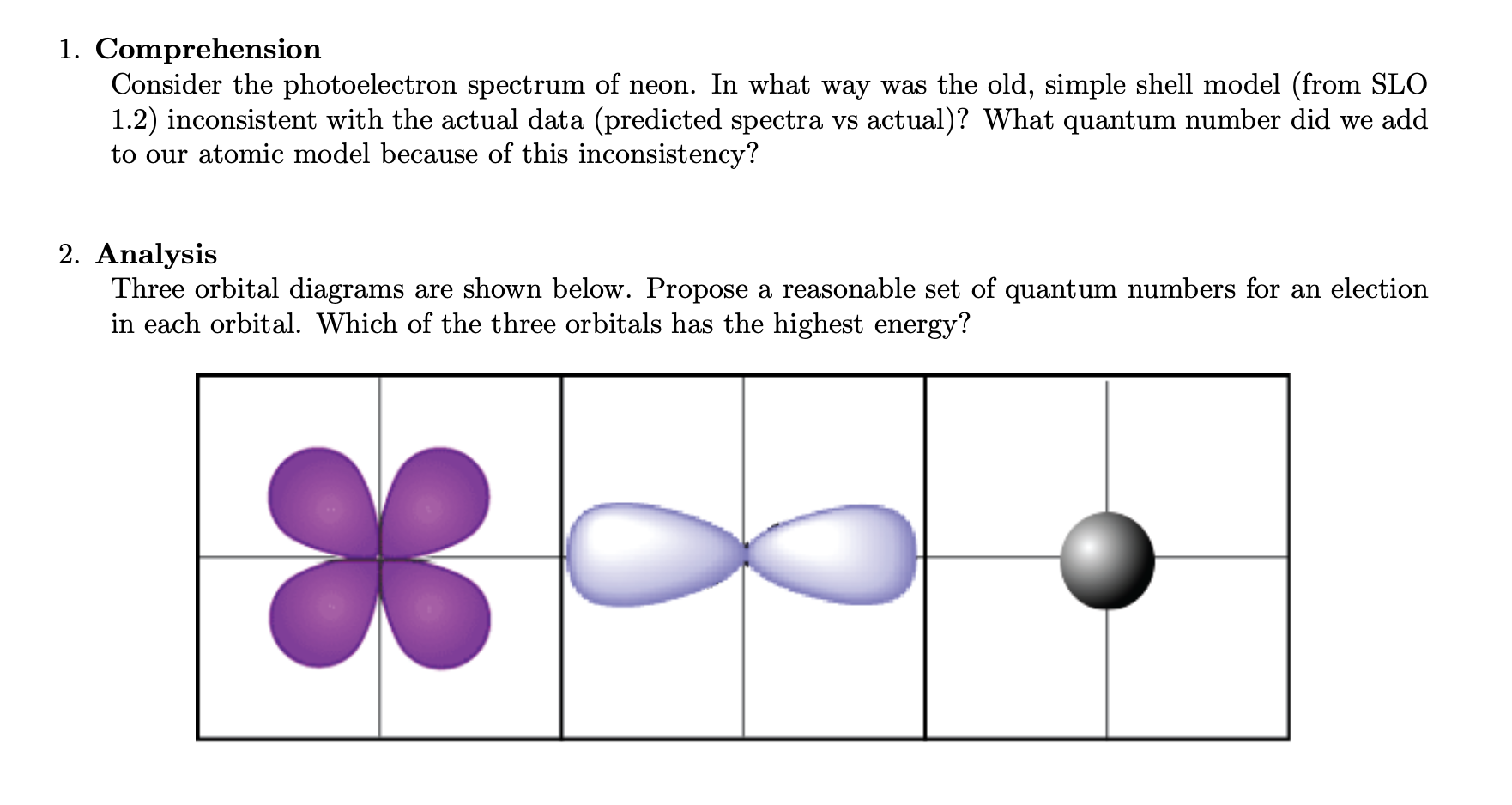SLO 3.1 Electronic Structure
Describe the electronic structure of matter using data and models
 Key Concepts and Skills
Key Concepts and Skills
- Orbitals: Depict the general shape and thus region of space an electron would most likely be found based on its shell and subshell.
- Electron Configurations of Atoms and Ions: Write electron configurations for atoms/ions using full notation, orbital box diagram notation, and noble-gas shorthand not including irregular filling patterns. Identify neutral atoms given a ground state electron configuration.
- Photoelectron Spectroscopy: Explain the photoelectric effect and identify the key features of a photoelectron spectrum and the information that can be obtained from it. Draw a photoelectron spectrum from an energy level diagram and vice versa. Explain why the basic shell model fails to predict the photoelectron spectrum of atoms. Explain how the observed magnetic properties of an atom provide information about electron configuration.
- Quantum Numbers: Given a particular electron determine a possible set of quantum numbers, evaluate statements about the relationship between quantum numbers, electron configurations and relative energy of electrons of atoms. Assess the validity of a set of quantum numbers.
- Diamagnetism Identify atoms and ions as diamagnetic/paramagnetic by analyzing electron configurations.
 Reading
Reading
- From the textbook:
- 8.1 Schrodinger’s Cat
- 8.2 The Nature of Light
- 8.3 Atomic Spectroscopy and the Bohr Model
- 8.5 Quantum Mechanics and the Atom
- 8.6 The Shapes of Atomic Orbitals
- 9.3 Electron Configurations: How Electrons Occupy Orbitals
- 9.4 Electron Configurations, Valence Electrons, and the Periodic Table
- POGIL Activities
- CA-8: What is Photoelectron Spectroscopy?
- CA-9: Does the Shell Model Change Again When More Data is Obtained?
- CA-F: Where Do Electrons Hang Out?
- Other:
 Important Terms
Important Terms
| Shell | Photoelectric effect |
| Subshell | Quantum number |
| Orbital | Principal quantum number (\(n\))] |
| Electron Spin | Angular momentum quantum number (\(l\)) |
| Diamagnetic | Magnetic quantum number (\(m_l\))) |
| Paramagnetic | Spin quantum number (\(m_s\)) |
| Wavelength | Electromagnetic radiation |
| Frequency | Ionization energy |
 Sample Assessment Questions
Sample Assessment Questions

 Dr. Thompson Videos
Dr. Thompson Videos
-
Photoelectron Spectroscopy
-
Quantum Numbers
-
Electron and Orbital Configurations
 External Videos, Tutorials, Simulations
External Videos, Tutorials, Simulations
- Khan Academy - Quantum Numbers
- Crash Course Chemistry - Electrons
- Organic Chemistry Tutor - Subshells
- Khan Academy - Electron Configurations
- Photoelectron Spectroscopy
- Electron Configurations
- Electron Configurations of Ions
 Practice Problems
Practice Problems
- From the textbook:
- 8.1, 8.3, 8.27-29, 8.57-64, 8.66, 8.78, 8.81, 9.18-19, 9.39-48, 9.83-86
- From other external sources:
- From Dr. Thompson (links and embedded versions below):